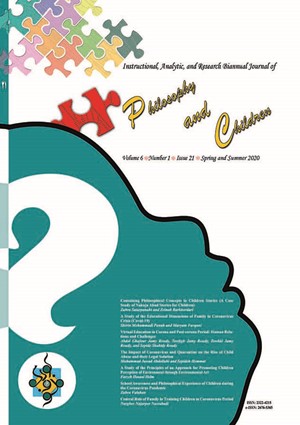A Study of the Principles of an Approach for Promoting Children Perception of Environment through Environmental Art
Subject Areas : Children, games, and social skills
1 -
Keywords: perception of children environmental concepts skill of thinking children art ,
Abstract :
Today, a modern and strategic approach has come out for teaching the environmental concepts to the children which is based on environmental art. The aim of this approach is to turn the environmental crisis into a thoughtful discourse for deepening our understanding, improving the techniques, nourishing our feeling and sentiments in order to have a different and fresh view towards the relationship between man and environment. The present article proceeds to study the principles of various solutions through which we can apply it to environmental art which leads to the enhancement of environmental understanding of children. Accordingly, the present work follows a descriptive- analytic method according to which the role of art creations and researches in nature will be used to promote the environmental awareness of children. The findings of this work indicate that environmental art by establishing easy relationship with the audiences by taking into account the objective, empirical, and reflective consideration can turn out to be a suitable method for children in their approach towards the environment. One of the main features of this approach is that it is based on visual, symbolic and conceptual method of environmental art versus mere scientific method of certain approaches.
بنسون، جان (1393) اخلاق محیط زیست، ترجمة عبدالحسین وهابزاده، تهران: جهاد دانشگاهی.
حسنپور، محسن؛ كثيري، اعظم؛ ايلوخاني، آتوسا؛ ایلوخانی، مسعود (1395) هنر در دنیای امروز، تهران: شهید رجایی.
دیوئی، جان (1391) هنر بمنزلة تجربه، ترجمة مسعود اولیاء، تهران: ققنوس.
ریختهگران، محمدرضا (1386) حقیقت و نسبت آن با هنر، تهران: پژوهشگاه فرهنگ و هنر اسلامی.
سوداگر، محمدرضا (1390) «ضرورت وساطت هنر بر آموزش به کودکان»، تفکر و کودک، سال دوم، شمارة اول.
قائدی، یحیی (1395) مبانی نظریه فلسفه بر کودکان، تهران: مرآت.
كان، پيتر، كلرت، استفن (1394) كودك و طبيعت، ترجمه عبدالحسين وهابزاده و آرش حسينيان، تهران: جهاد دانشگاهي.
لوو، ريچارد (1395) آخرين كودك جنگل، ترجمة آرش حسينيان، تهران: تلنگر.
ويلسون، رات (1395) طبيعت و كودك خردسال، ترجمة عبدالحسين وهابزاده، تهران: صحرا.
Boeckel, J.V. (2009). Arts-based environmental education and the ecological crisis: Between opening the senses and coping with psychic numbing. Metamorphoses in Children's Literature and Culture (pp.145-164). Turku, Finland: Enostone.
Flowers, A. et al. (2019). Effects of an art-based environmental education camp program on the environmental attitudes and awareness of diverse youth. The journal of environmental education. 50, 208-222.
Frantz, C.M. & Mayer, S. (2014). The importance of connection nature in assessing environmental education. Studies in educational evaluation. 41, 85-89.
Gur, C. (2011). International conference on education and educational psychology philosophy in the early years (pp. 501-511); www.sciencedirect.com/Procedia-social and behavioral sciences 12.
Inwood, H.J. (2013). Cultivating artistic approaches to environmental learning: Exploring eco-art education in elementary classroom. International electronic journal of environmental education. Vol.3, Issue 2.
Mantere, M-H. (2014). Coming back to the sense, an artistic approach to environmental education. Published at: www.natureart.edu
Plumwood, V. (1991). Nature, self and gender: feminism, environmental philosophy and the critique of rationalism (pp. 3-27). Published by: Wiley.
Turgeon, W. (2015). Philosophy for children and environmental philosophy. https://www. academia.edu/35059083/Philosophy_for_Children_and_Environmental_philosophy_docx.
York, R. A. (2014). Re-connecting with nature: Transformative environmental education through the arts. Ph.D. thesis, University of Toronto.


